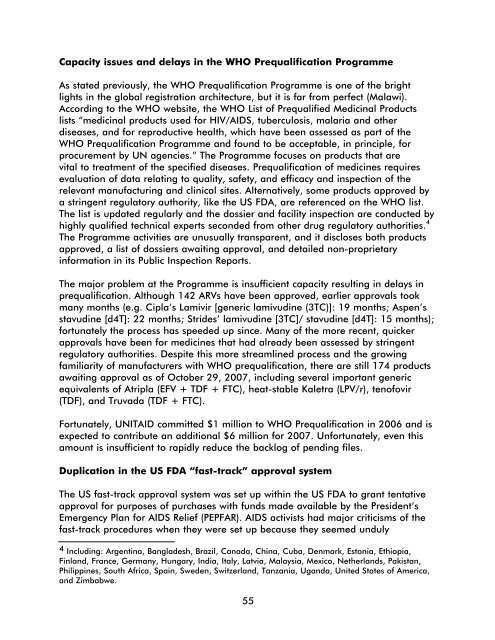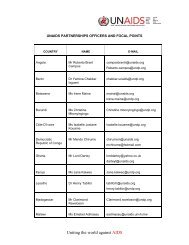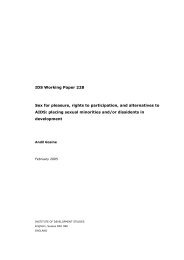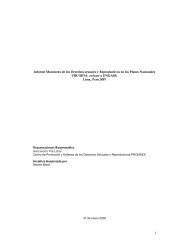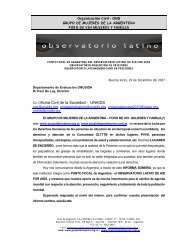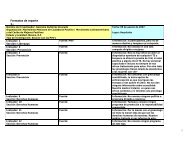Missing the Target #5: Improving AIDS Drug Access ... - CD8 T cells
Missing the Target #5: Improving AIDS Drug Access ... - CD8 T cells
Missing the Target #5: Improving AIDS Drug Access ... - CD8 T cells
You also want an ePaper? Increase the reach of your titles
YUMPU automatically turns print PDFs into web optimized ePapers that Google loves.
Capacity issues and delays in <strong>the</strong> WHO Prequalification ProgrammeAs stated previously, <strong>the</strong> WHO Prequalification Programme is one of <strong>the</strong> brightlights in <strong>the</strong> global registration architecture, but it is far from perfect (Malawi).According to <strong>the</strong> WHO website, <strong>the</strong> WHO List of Prequalified Medicinal Productslists “medicinal products used for HIV/<strong>AIDS</strong>, tuberculosis, malaria and o<strong>the</strong>rdiseases, and for reproductive health, which have been assessed as part of <strong>the</strong>WHO Prequalification Programme and found to be acceptable, in principle, forprocurement by UN agencies.” The Programme focuses on products that arevital to treatment of <strong>the</strong> specified diseases. Prequalification of medicines requiresevaluation of data relating to quality, safety, and efficacy and inspection of <strong>the</strong>relevant manufacturing and clinical sites. Alternatively, some products approved bya stringent regulatory authority, like <strong>the</strong> US FDA, are referenced on <strong>the</strong> WHO list.The list is updated regularly and <strong>the</strong> dossier and facility inspection are conducted byhighly qualified technical experts seconded from o<strong>the</strong>r drug regulatory authorities. 4The Programme activities are unusually transparent, and it discloses both productsapproved, a list of dossiers awaiting approval, and detailed non-proprietaryinformation in its Public Inspection Reports.The major problem at <strong>the</strong> Programme is insufficient capacity resulting in delays inprequalification. Although 142 ARVs have been approved, earlier approvals tookmany months (e.g. Cipla’s Lamivir [generic lamivudine (3TC)]: 19 months; Aspen’sstavudine [d4T]: 22 months; Strides’ lamivudine [3TC]/ stavudine [d4T]: 15 months);fortunately <strong>the</strong> process has speeded up since. Many of <strong>the</strong> more recent, quickerapprovals have been for medicines that had already been assessed by stringentregulatory authorities. Despite this more streamlined process and <strong>the</strong> growingfamiliarity of manufacturers with WHO prequalification, <strong>the</strong>re are still 174 productsawaiting approval as of October 29, 2007, including several important genericequivalents of Atripla (EFV + TDF + FTC), heat-stable Kaletra (LPV/r), tenofovir(TDF), and Truvada (TDF + FTC).Fortunately, UNITAID committed $1 million to WHO Prequalification in 2006 and isexpected to contribute an additional $6 million for 2007. Unfortunately, even thisamount is insufficient to rapidly reduce <strong>the</strong> backlog of pending files.Duplication in <strong>the</strong> US FDA “fast-track” approval systemThe US fast-track approval system was set up within <strong>the</strong> US FDA to grant tentativeapproval for purposes of purchases with funds made available by <strong>the</strong> President’sEmergency Plan for <strong>AIDS</strong> Relief (PEPFAR). <strong>AIDS</strong> activists had major criticisms of <strong>the</strong>fast-track procedures when <strong>the</strong>y were set up because <strong>the</strong>y seemed unduly4 Including: Argentina, Bangladesh, Brazil, Canada, China, Cuba, Denmark, Estonia, Ethiopia,Finland, France, Germany, Hungary, India, Italy, Latvia, Malaysia, Mexico, Ne<strong>the</strong>rlands, Pakistan,Philippines, South Africa, Spain, Sweden, Switzerland, Tanzania, Uganda, United States of America,and Zimbabwe.55


